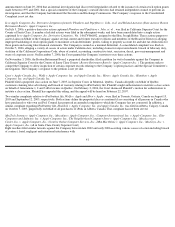Apple 2006 Annual Report Download - page 51
Download and view the complete annual report
Please find page 51 of the 2006 Apple annual report below. You can navigate through the pages in the report by either clicking on the pages listed below, or by using the keyword search tool below to find specific information within the annual report.
In June 2005, the Company announced its plan to begin using Intel microprocessors in its computers. During 2006, the Company introduced
new Intel-based models of the MacBook Pro, MacBook, Mac Pro, iMac, and Mac mini computers. The Company’s transition to Intel
microprocessors for Macintosh systems was completed in August 2006, and its transition for Xserve was completed in November 2006. The
MacBook Pro, MacBook, Mac Pro, iMac, and Mac mini feature Mac OS X version 10.4 Tiger, iLife ‘06, and the Company’s new translation
technology, Rosetta, which allows most PowerPC-based Macintosh applications to run on Intel-based Macintosh computers. There are
potential risks and uncertainties that may occur due to this transition, which are further discussed in Item 1A under the heading “Risk Factors.”
The Company utilizes a variety of direct and indirect distribution channels. The Company believes sales of its innovative and differentiated
products are enhanced by knowledgeable salespersons who can convey the value of the hardware, software, and peripheral integration,
demonstrate the unique digital lifestyle solutions that are available only on Macintosh computers, and demonstrate the compatibility of the
Macintosh with the Windows platform and networks. The Company further believes providing a high-quality sales and after-sales support
experience is critical to attracting and retaining customers. To ensure a high-quality buying experience for its products in which service and
education are emphasized, the Company has expanded and improved its distribution capabilities by opening its own retail stores in the U.S. and
internationally. The Company had 165 stores open as of September 30, 2006.
The Company also staffs selected third-party stores with the Company’s own employees to improve the buying experience through reseller
channels. The Company has deployed Apple employees and contractors in reseller locations around the world including the U.S., Europe,
Japan, and Australia. The Company also sells to customers directly through its online stores around the world.
To improve access to the iPod product line, the Company has significantly expanded the number of distribution points where iPods are sold.
The iPod product line can be purchased in certain department stores, member-only warehouse stores, large retail chains, and specialty retail
stores, as well as through the channels listed above.
Critical Accounting Policies and Estimates
The preparation of financial statements and related disclosures in conformity with U.S. generally accepted accounting principles and the
Company’s discussion and analysis of its financial condition and results of operations require the Company’s management to make judgments,
assumptions, and estimates that affect the amounts reported in its consolidated financial statements and accompanying notes. Note 1 of the
Notes to Consolidated Financial Statements of this Form 10
-K describes the significant accounting policies and methods used in the
preparation of the Company’s consolidated financial statements. Management bases its estimates on historical experience and on various other
assumptions it believes to be reasonable under the circumstances, the results of which form the basis for making judgments about the carrying
values of assets and liabilities. Actual results may differ from these estimates and such differences may be material.
Management believes the Company’
s critical accounting policies and estimates are those related to revenue recognition, allowance for doubtful
accounts, inventory valuation and inventory purchase commitments, warranty costs, stock-
based compensation, and income taxes. Management
believes these policies to be critical because they are both important to the portrayal of the Company’s financial condition and results, and they
require management to make judgments and estimates about matters that are inherently uncertain. The Company’s senior management has
reviewed these critical accounting policies and related disclosures with the Audit and Finance Committee of the Company’
s Board of Directors.
Revenue Recognition
Net sales consist primarily of revenue from the sale of hardware, software, peripherals, digital content, and service and support contracts. The
Company recognizes revenue pursuant to applicable accounting
50
























